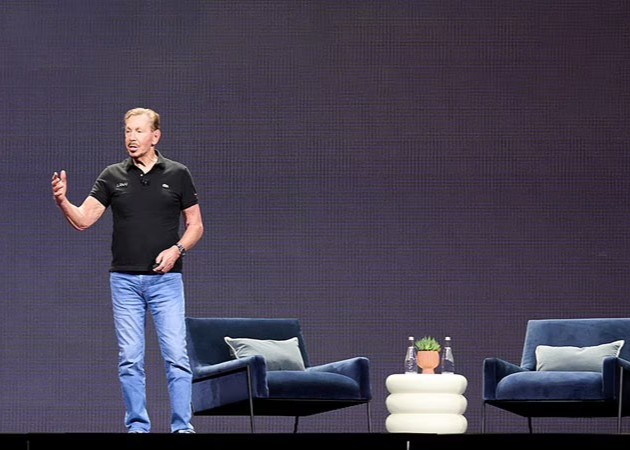Software
CloudWorld 2024:
Cloud wars end
Oracle founder Larry Ellison and Amazon Web Services CEO Matt Garman made for a startling scene in Las Vegas, writes ARTHUR GOLDSTUCK.
The most dramatic moment of the recent Oracle CloudWorld 2024 in Las Vegas occurred during company founder and chairman Larry Ellison’s keynote address, but it was not a product announcement.
It came when Ellison was joined on stage by Matt Garman, CEO of Amazon Web Services (AWS) – which until a few hours earlier had been regarded as Oracle’s mortal enemy. In previous editions of CloudWorld, which draws up to 60,000 delegates to one of the world’s largest software conferences, Ellison had railed against cloud computing market leader AWS, firing broadsides at anything from its pricing to its market dominance.
On the eve of CloudWorld, Oracle sent a lightning bolt into the cloud: it announced the launch of Oracle Database@AWS, which would allow customers to access Oracle software and services within the AWS cloud. In effect, it will integrate the two clouds, or at least seamlessly integrate data in the one with applications in the other.
This will improve flexibility, reliability, and scalability for customers of both companies. In turn, it will help companies connect and analyse data across the two clouds, simplify procurement, unify support and enhance data backups.
Against the backdrop of a video display emblazoned with the words “MultiCloud Era Begins”, Ellison spoke of a time when the Oracle database ran on different different kinds of computers and different operating systems.
“We coexisted with different applications… different vendors ran on Oracle, and it was the whole idea that customers had a lot of choices. But when we moved into the very exciting world of cloud, with a lot of tremendous benefits, It seems like we lost one thing.
“We lost the idea that customers could buy technology from many different companies, and those technologies would work gracefully together. Now, as we’re well into the cloud era, we’re entering the new phase. The clouds are becoming open. They’re no longer waled gardens, but customers will have choices and use multiple clouds together.”
Ellison was remarkably frank in acknowledging that the customer was not best served in this environment.
“All of you out there use multiple clouds. There are four very, very large infrastructure companies that have big clouds: AWS, Microsoft Azure, Google and Oracle. Customers typically use one or two or even three different infrastructure clouds. Today, those clouds really don’t work well together. They’re not gracefully integrated.”
He also made a tacit admission that relations with Amazon had been strained.
“Years and years and years ago, we had a very wonderful relationship with Amazon, and we have lots of customers in common. I think we both listen to those customers. Some of them certainly asked me over and over again, when will we be able to use your database inside of AWS, and now we can tell them that will be December in 2024.”
With that, he welcomed Garman onto stage, although their greeting – a quick and cordial handshake – suggested it would take time for the relationship to warm up.
Both have much to gain. Oracle struck similar deals with Microsoft and Google, respectively, in March and June this year, making the AWS agreement the final jolt of a seismic shift in the cloud world. Garman, for his part, acknowledged the appeal of Oracle’s database software.
“There’s a wide variety of customers who choose to run in AWS. They love the security of AWS, they love the scalability of AWS, and they want to run some of their most mission-critical workloads. They already run them on Oracle, and they really wanted to run all of those mission critical workloads inside of AWS, where their applications are, but they need low latency to their database.”
Garman echoed Ellison’s sentiments that it was a customer-driven decision.
“Giving customers choices has always been good for our business. I think it’s going to work out well for us and well for all the people here today. What I found is that, when we listen to customers and we really listen to what they’re looking for, that’s when we deliver an outstanding product.”
Cormac Watters, Oracle executive vice president of applications for Europe, Middle East, and Africa, told us after the event that integration of applications had become even more important with the advent of generative AI.
“The challenge for the customer comes when they want the next solution,” he said. “So if you buy Human Capital Management, what happens when you want to put in supply chain software? What happens when you want to put in finance, and you’re going to go for three separate solutions, and they’re all best of breed? You won’t be able to take advantage of generative AI.
“Suddenly, the integration of all the applications has becomes a topic of conversation in the C-Suite. If they’re separate systems, what about the data underneath? Will it be one common data model?”
The outcome of this discussion, he said, was crucial for companies that intend to utilise AI. He gave the example of a South African bank with whom he had been in discussions. It was exploring both HR and procurement applications, but as separate projects.
“Should they be connected? Because if it’s not, then you will have problems with maximising the opportunity to utilise AI.”
* Arthur Goldstuck is CEO of World Wide Worx and editor-in-chief of Gadget.co.za. Follow him on social media on @art2gee.



















